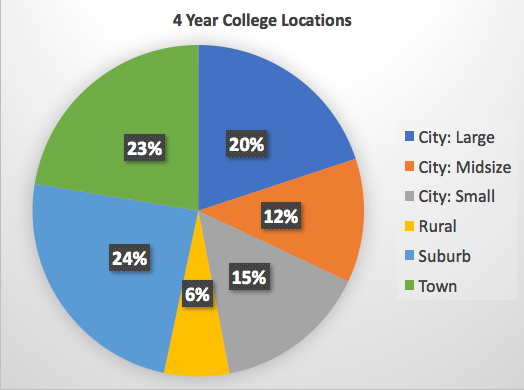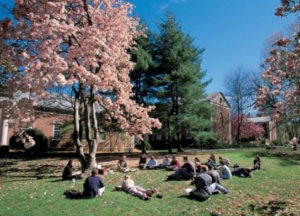“Location, location, location” is a real estate truism that also applies to selecting a school. Yet, students and parents sometimes focus so closely on the features of a college or university that they fail to consider the environment in which it is located. Whether a college campus is situated in a large city or a small town makes a big difference in the college experience.
For some students, moving away to a big city is part of the appeal of college. With plenty of places to work, play, socialize and explore new interests, the pace of life can be exciting. In addition, certain cities may offer opportunities to get involved in a particular industry. However, big cities are not the ideal college location for everyone. Cities can be stressful, lonely and expensive places, especially for homesick college students.
 College campuses in small towns and rural areas offer different pros and cons. A small-town campus typically offers a closer-knit community of students to support each other and more opportunities for outdoor recreation. However, job prospects can be more limited, both for regular employment and professional internships. A smaller student body can lack diversity, and some students may find they are unable to find activities they find interesting and fun.
College campuses in small towns and rural areas offer different pros and cons. A small-town campus typically offers a closer-knit community of students to support each other and more opportunities for outdoor recreation. However, job prospects can be more limited, both for regular employment and professional internships. A smaller student body can lack diversity, and some students may find they are unable to find activities they find interesting and fun.
The good news is that colleges are located in many different kinds of places: rural, urban, suburban, and somewhere in-between. More than 11,000 resident students choose New York University’s main Washington Square Park campus in lower Manhattan. They have access to all the cultural activities, architecture, history and nightlife the city of 8.5 million offers. At the other extreme, 1,600 students attend Grinnell College in picturesque Grinnell, Iowa, a town of 9,000 residents known as the “the Jewel of the Prairie.” Here, Miller Park’s 18-basket disc golf course is a popular spot.
Clearly, there are many kinds of college experiences students can choose. With so many options, how can students and their parents decide? First, they really need to think about what kind of campus experience they desire and where they think they can achieve a lifestyle balance that will sustain them. They also need to realize that they don’t have to choose between a bustling, high-density metropolitan area and the rolling plains of mid-America.
Can You Have the Best of Both Worlds on One Campus?
One example of a college that offers a happy compromise between big city and small town is Drew University in Madison, New Jersey, a borough of 15,000 people located just 25 miles west of New York City. Drew University, a Phi Beta Kappa college, is well known for the strength of its faculty, liberal arts experiential education, and top-five national theater program, all housed on a wooded, 186-acre campus.
Nicknamed the “University in the Forest”, Drew has one of the most beautiful and serene campuses of any university in the country. Yet, it is located in a small town only 50 minutes from New York City by train. Students at Drew can take advantage of all the professional opportunities and internships available in the city, without having to move away from campus. Drew offers New York-based semester-long programs in subjects including social entrepreneurship, communications and media, New York theater, the United Nations, contemporary art, and Wall Street.

Drew University Students on the Lawn
Northern New Jersey is also home to many research-oriented companies, especially in the pharmaceutical and telecommunications industries. Drew and it’s home of Madison are strategically located to attract researchers from these companies when they retire, which is part of the reason Drew has been able to bring in experienced industrial scientists for its undergraduate research efforts.
For many students, a choice like Drew University offers the best of both worlds. But, every student wants something slightly different out of college, so this is an extremely personal decision and there is no one right answer.
Ultimately, the primary consideration should be the school itself, including degree programs, costs, acceptance criteria, graduation rates, student-to-faculty ratio and reputation.
But, the location of the school matters, too. Many students have fantasies of life in the big city, or enjoying the fall colors at a beautiful rural college, but if they look hard enough, sometimes they can find everything they need in an unexpected college campus.
